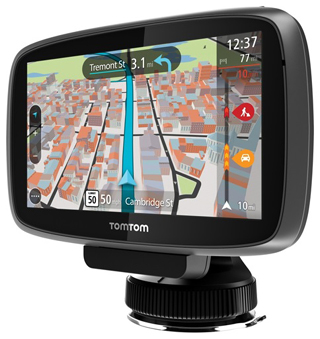 TomTom has already updated its GPS lineup Go series in Europe back in April and today, the company launched the new TomTom Go Series with TomTom Traffic in the US.
TomTom has already updated its GPS lineup Go series in Europe back in April and today, the company launched the new TomTom Go Series with TomTom Traffic in the US.The most significant update is the total re-thinking and re-design of the user interface, and from the screen shots I saw, it looks really promising: everything looks sleeker and nicer, the color scheme is much more harmonious and all the information looks easier to access from the main screen than on the past generation. One key feature I really like is the route bar located on the right side of the screen which lets users see what is coming on the road ahead of time. The software update is really a great improvement (on the paper) over the last generation of Go devices launched at CES 2011.
On the hardware side the key update is the absence of internal 2G/Edge cellular radio, you need to pair your TomTom Go over Bluetooth with your smartphone where you download the companion Traffic app (iOS and Android).
TomTom Go Devices pricing, availability and features
The TomTom Go series will be divided in three sizes: 6-inch for the TomTom Go 60 at $159, the TomTom Go 60 S at $199, and the TomTom Go 600 at $299, 5-inch for the TomTom Go 50 at $129, the TomTom Go 50 S at $169, and the TomTom Go 500 at $249 and 4.3-inch the TomTom Go 40 at $119, TomTom Go 40 S at $149. All the devices will be available in April 2014.
The Go 60, 50 and 40 get Lifetime Maps (US) and a free trial of TomTom Traffic via smartphone, the Go 60 S, 50 S and 40 S offer Lifetime Maps (Northern America), free TomTom Traffic via smartphone and 3D Maps, the Go 600 and 500 get Lifetime Maps (Northern America), free TomTom Traffic via smartphone, 3D Maps, Bluetooth hands free voice calling, voice recognition and pinch-to-zoom.
It is hard to describe a user interface just from screen shots, but here are the key features of the new software:
TomTom Traffic: more reliable, more coverage and more accurate – according to the company

The new TomTom Go product lineup offers TomTom traffic, a technology that relies on OpenLR, a royalty-free open source technology and open Industry standard launched by the company in September 2009 that provides dynamic location referencing which is map-agnostic (any maps from any vendors can work) and channel agnostic (location information can be transferred over IP or over FM radio for example). The most well-known and most used method to transfer traffic information today is RDS-TMC and uses a different Location Referencing method than OpenLR, and, according to TomTom, it has a more limited amount of locations that can be transferred due to its different location encoding process. (More detailed on OpenLR here, here and here)

Consequently, TomTom Go devices get a better coverage of small roads across the US than devices using the TMC-RDS traffic information (see the graph above and on the OpenLR page). Traffic events and data can be collected on those secondary and tertiary roads by TomTom Traffic, while they are not by TMC. According to the company, TomTom Traffic now reports a average of 20% more traffic incidents than TMC.
Regarding real time traffic, TomTom claims that it crowd source data from over 350 million drivers around the world (over 150 million in North America) combined with information from major traffic authorities, while its competitors gather info from less than 100 million drivers. There was no word from the company on how it compares to FCD (Floating Car Data) used by Google and Waze, which use position data of smartphones to map the traffic flow in real time.
Last but not least, TomTom claims it provides better accuracy for traffic jam location, down to 30 feet while its competition gets only 300 feet of precision.
Now TomTom Traffic offers Jam Ahead Warning, Road Closure Detection and Road Works Detection. The automatic detection of road closures is now extended and includes major secondary roads as well as highways

3D Maps
Now TomTom get good looking 3D maps, see the picture above.
Interactive Maps with Pinch-to-Zoom in high-end model
The brand new maps displayed on the high resolution touch screen allows user to easily access the travel information. The Go 500 and Go 600 offer pinch-to-zoom.

My Places and Tap & Go
You can easily add your favorite places on the map, then you will just have to tap directly on the icon place to get the TomTom Go start the route.

Quick Search: Drivers can find their destination faster with intuitive search results. Quick Search starts finding destinations as soon as the driver starts typing.

Route Bar
The route bar is a feature I have seen in the new Mapquest app as well. It allows to visually get a representation of what the road ahead which is not yet included in the main view,will look like in terms of traffic jams, incidents or point of interests. (see picture)
Lifetime Maps
For the life of the product, drivers can download four or more full updates of the map onto the device, every year. Drivers receive all updates to the road network, addresses and Points of Interest.
Filed in . Read more about CES, CES 2014, GPS, Location-based and Tomtom.